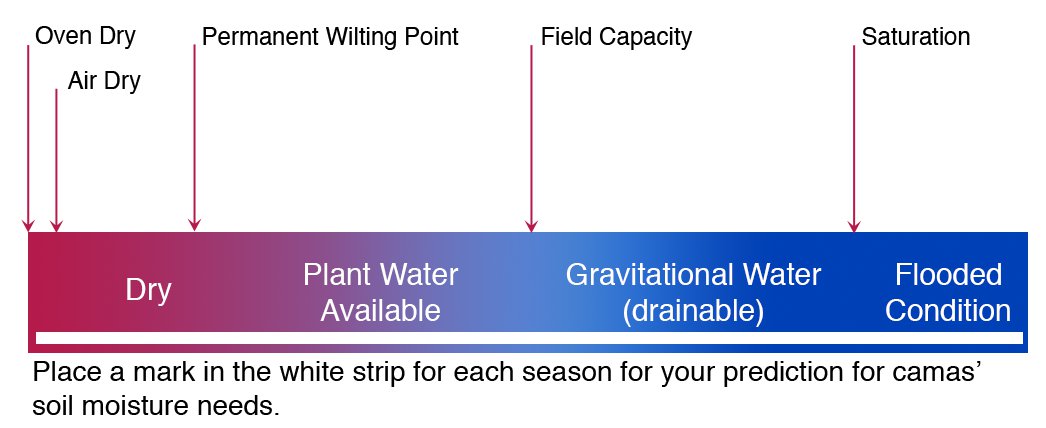Search this Site
Culture, Climate Science & Education
Lab Nine
Using Satellite-Collected Soil Moisture (SMAP) Data to Assess the Impacts of Climate Change on Camas Growth and Disturbance
Authors: Cynthia Coleman, Tyrel Fenner, and Jacob Clairmont and Dr. Adrian Leighton and David Rockwell
Note to Instructors: This lab can be done with other plants that require moist soil conditions
Soil moisture, one of the most important variables linked to plant performance during the growing season, is the water that is held in the spaces between soil particles. Surface soil moisture is the water in the upper 5 to 10 cm of soil. In January of 2015, NASA launched SMAP, a satellite designed to measure surface soil moisture. Climate change is expected to impact soil moisture in many areas in significant ways. For example, researchers forecast a threefold increase in drought frequency in many regions of the world by the end of the 21st Century. In addition, climate change is expected to profoundly change the seasonal timing of precipitation and whether if falls as rain or snow. These predictions concern First Nations communities because drought can adversely affect culturally important plants like camas, a major food plant for many tribes in the Northwest and Plateau regions. Right now, scientists know little about how climate change will affect soil moisture in those regions, so little is known about the potential impacts on camas.
The purposes of this lab are: (1) to understand how soil moisture affects the distribution and growth of camas, a culturally important food plant for the Salish, Pend d’Oreille and Kootenai people and (2) learn how to use regional climate data to make predictions or draw inferences about how changes in precipitation and temperature will affect soil moisture and how those changes could affect camas. You will also learn the value of the SMAP program and the importance of field validation of remotely sensed data.
Step 1: Learn about (1) soil moisture, (2) the SMAP satellite program, (3) the importance of validating large-scale data sets, and (4) the soil moisture requirements of camas and how soil moisture affects this culturally important plant's growth and distribution.
What is Soil Moisture?
Soil moisture is difficult to define because it means different things in different disciplines. For example, a farmer's concept of soil moisture is different from that of a water resource manager or a weather forecaster. Generally, however, soil moisture is the water that is held in the spaces between soil particles. Surface soil moisture is the water that is in the upper 5 to 10 cm of soil, whereas root zone soil moisture is the water that is available to plants, which is generally considered to be in the upper 200 cm of soil.
Why is Measuring Soil Moisture Important?
Compared to other components of the hydrologic cycle, the volume of soil moisture is small; nonetheless, it is of fundamental importance to many hydrological, biological and biogeochemical processes. Soil moisture information is valuable to a wide range of government agencies and private companies concerned with weather and climate, runoff potential and flood control, soil erosion and slope failure, reservoir management, geotechnical engineering, and water quality.
Soil moisture is a key variable in controlling the exchange of water and heat energy between the land surface and the atmosphere through evaporation and plant transpiration. As a result, soil moisture plays an important role in the development of weather patterns and the production of precipitation. Simulations with numerical weather prediction models have shown that improved characterization of surface soil moisture, vegetation, and temperature can lead to significant forecast improvements. Soil moisture also strongly affects the amount of precipitation that runs off into nearby streams and rivers. Large-scale dry or wet surface regions have been observed to impart positive feedback on subsequent precipitation patterns, such as in the extreme conditions over the central U.S. during the 1988 drought and the 1993 floods. Soil moisture information can be used for reservoir management, early warning of droughts, irrigation scheduling, and crop yield forecasting.
Soil water serves as a carrier of food nutrients for plant growth. In fact, plant biomass for a given area is more often determined by the amount of water available rather than the deficiency of other food nutrients for a variety of reasons:
- Soil water acts as a nutrient itself;
- Soil water regulates soil temperature;
- Soil forming processes and weathering depend on water;
- Microorganisms require water for their metabolic activities;
- Soil water helps in chemical and biological activities of soil;
- It is a principal constituent of the growing plant; and
- Water is essential for photosynthesis.
You can also visit the SMAP website.
After watching the video, your instructor will lead a class discussion on the importance of globally scaled soil moisture data and the importance of validating large-scale data sets like that produced by SMAP.
Visit the Globe website to learn about how schools and colleges can participate in validating large-scale data sets. With the help of your instructor, review and interact with the SMAP page of the website so you know how to navigate through it and upload your own data after you collect it.
Inferring conditions about the earth’s surface using remotely sensed measurements almost always requires the use of reference, or “ground truth” data, in other words, data that is collected in the field. Those ground-based field measurements typically involve collecting measurements of the phenomena or target being remotely sensed, in this case soil moisture data, which will be used to help validate the remotely sensed SMAP data. Generally, ground-truth data is used to assist with (1) image analysis and interpretation (e.g. image classification) of remotely sensed imagery, (2) remote sensor calibration, and (3) accuracy assessment of image analysis results.
Much of the emphasis on collecting ground truth is for verification and assessment. When a remote sensing or image processing technique is under development, it is mandatory to have sufficient ground truth data to test not only the accuracy of the final image analysis output, but also the intermediate steps in that process. General guidance for ground truth collection in remote sensing research and development (R&D) is dependent on specifics of the technology being developed. By participating in this lab, you are (1) assisting NASA’s SMAP team as they develop the protocols for ground-truth data collection through the use of sensors and an app and (2) helping validate SMAP data.
Your instructor will use several resources (a pdf on phytogeography of Camas and research by SKC students and faculty) to lead a discussion about the natural history of camas (Camassia quamash) and its soil moisture requirements.
Predict what the soil moisture conditions will be by printing the soil-moisture scale below and placing a mark on the spot that you think
best represents the soil moisture needs of camas. Make one mark for each of the four seasons. To print the scale, click on the printer icon at bottom right.

Step 2: Visit a camas field with students and a tribal elder (or the instructor of the Tribal Use of Plants class) and use the SMAP-developed probe to sample the soil according to the protocol found on the SMAP page of the Globe website.
Click on the button at right to download the protocol. Before you leave for the field, your instructor will go over the use of the sensor and the protocol.
Use the SMAP sensor to sample soil moisture according to the SMAP sensor protocol.
Return to the classroom and upload your data to the Globe SMAP website.
Use the knowledge you have gained about camas and the National Climate Change Viewer to see what climate change models predict for soil water storage your camas site (look at both the RCP8.5 and RCP4.5 models and make predictions for 3 different future time periods). Then predict the impact those changes will have on camas growth and distribution.
Conduct a videoconference with a SMAP team member to discuss your data and your conclusions and to learn how your data correlates with SMAP results.
Step 1: Learn about (1) soil moisture, (2) the SMAP satellite program, (3) the importance of validating large-scale data sets, and (4) the soil moisture requirements of camas and how soil moisture affects this culturally important plant's growth and distribution.
What is Soil Moisture?
Soil moisture is difficult to define because it means different things in different disciplines. For example, a farmer's concept of soil moisture is different from that of a water resource manager or a weather forecaster. Generally, however, soil moisture is the water that is held in the spaces between soil particles. Surface soil moisture is the water that is in the upper 5 to 10 cm of soil, whereas root zone soil moisture is the water that is available to plants, which is generally considered to be in the upper 200 cm of soil.
Why is Measuring Soil Moisture Important?
Compared to other components of the hydrologic cycle, the volume of soil moisture is small; nonetheless, it is of fundamental importance to many hydrological, biological and biogeochemical processes. Soil moisture information is valuable to a wide range of government agencies and private companies concerned with weather and climate, runoff potential and flood control, soil erosion and slope failure, reservoir management, geotechnical engineering, and water quality.
Soil moisture is a key variable in controlling the exchange of water and heat energy between the land surface and the atmosphere through evaporation and plant transpiration. As a result, soil moisture plays an important role in the development of weather patterns and the production of precipitation. Simulations with numerical weather prediction models have shown that improved characterization of surface soil moisture, vegetation, and temperature can lead to significant forecast improvements. Soil moisture also strongly affects the amount of precipitation that runs off into nearby streams and rivers. Large-scale dry or wet surface regions have been observed to impart positive feedback on subsequent precipitation patterns, such as in the extreme conditions over the central U.S. during the 1988 drought and the 1993 floods. Soil moisture information can be used for reservoir management, early warning of droughts, irrigation scheduling, and crop yield forecasting.
Soil water serves as a carrier of food nutrients for plant growth. In fact, plant biomass for a given area is more often determined by the amount of water available rather than the deficiency of other food nutrients for a variety of reasons:
- Soil water acts as a nutrient itself;
- Soil water regulates soil temperature;
- Soil forming processes and weathering depend on water;
- Microorganisms require water for their metabolic activities;
- Soil water helps in chemical and biological activities of soil;
- It is a principal constituent of the growing plant; and
- Water is essential for photosynthesis.
You can also visit the SMAP website.
After watching the video, your instructor will lead a class discussion on the importance of globally scaled soil moisture data and the importance of validating large-scale data sets like that produced by SMAP.
Visit the Globe website to learn about how schools and colleges can participate in validating large-scale data sets. With the help of your instructor, review and interact with the SMAP page of the website so you know how to navigate through it and upload your own data after you collect it.
Inferring conditions about the earth’s surface using remotely sensed measurements almost always requires the use of reference, or “ground truth” data, in other words, data that is collected in the field. Those ground-based field measurements typically involve collecting measurements of the phenomena or target being remotely sensed, in this case soil moisture data, which will be used to help validate the remotely sensed SMAP data. Generally, ground-truth data is used to assist with (1) image analysis and interpretation (e.g. image classification) of remotely sensed imagery, (2) remote sensor calibration, and (3) accuracy assessment of image analysis results.
Much of the emphasis on collecting ground truth is for verification and assessment. When a remote sensing or image processing technique is under development, it is mandatory to have sufficient ground truth data to test not only the accuracy of the final image analysis output, but also the intermediate steps in that process. General guidance for ground truth collection in remote sensing research and development (R&D) is dependent on specifics of the technology being developed. By participating in this lab, you are (1) assisting NASA’s SMAP team as they develop the protocols for ground-truth data collection through the use of sensors and an app and (2) helping validate SMAP data.
Your instructor will use several resources (a pdf on phytogeography of Camas, a pdf plant guide, and research by SKC students and faculty) to lead a discussion about the natural history of camas (Camassia quamash) and its soil moisture requirements.
Predict what the soil moisture conditions will be by printing the soil-moisture scale below and placing a mark on the spot that you think
best represents the soil moisture needs of camas. Make one mark for each of the four seasons. To print the scale, click on the printer icon at bottom right.

Step 2: Visit a camas field with students and a tribal elder (or the instructor of the Tribal Use of Plants class) and use the SMAP-developed probe to sample the soil according to the protocol found on the SMAP page of the Globe website (note, as of this writing the protocol had not been posted but is expected to be up in the fall of 2016).
Click on the buttons at right to download the protocol and app. Before you leave for the field, your instructor will go over the use of the sensor, the protocol, and the app.
Use the SMAP sensor and app to sample soil moisture according to the SMAP sensor/app protocol.
Return to the classroom and upload your data to the Globe SMAP website.
Use the knowledge you have gained about camas and the National Climate Change Viewer to see what climate change models predict for soil water storage your camas site (look at both the RCP8.5 and RCP4.5 models and make predictions for 3 different future time periods). Then predict the impact those changes will have on camas growth and distribution.
Conduct a videoconference with a SMAP team member to discuss your data and your conclusions and to learn how your data correlates with SMAP results.
© 2018 SKC | Contact Us


